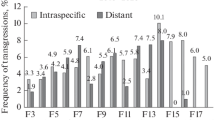Abstract
The character of inheritance of the determinate stem growth type in a garden pea form having four productive nodes (cv. Pervenets with a dwarf stem) has been first studied. The analysis of first-generation hybrids obtained from crosses between indeterminate forms and determinate samples (DTR-2 and DTR-4) showed that the phenotype of all plants was characterized by a usual stem growth type and formation of buds in the stipule axiles. In the case of DTR crosses between themselves, all plants corresponded to the DTR-2 phenotype. In the case of the cross combination (indeterminate form × DTR-2), segregation at a 3 : 1 ratio was observed in the second generation. In the case of the (indeterminate form × DTR-4) variant, phenotypes of resulting plants were segregated into four classes indicating the presence of two genes. For the (DTR-2 × DTR-4) cross, a 3 : 1 segregation was observed in relation to the early bud production. The inheritance of the “number of productive nodes” trait in the cv. Pervenets is determined by two genes, one of which is not related to the determination. This fact was confirmed by the test crossing with the further evaluation of the deviation of the actual segregation from the expected one using the χ2 (chi-square) method. According to the obtained data, the crossing [DTR-2 × (Voronezhsky zeleniy × Ranniy 28-11-early budding)] resulted in a new variety characterized by a limited stem growth type and four fertile nodes that is suitable for mechanical harvesting.
Similar content being viewed by others
REFERENCES
Nemecek, T., Kägi, T., and Blaser, S., Life cycle inventories of agricultural production systems, in Final Report Ecoinvent V2.0 Zurich, Dübendorf, CH: Swiss Centre for Life Cycle Inventories, 2007, no. 15.
Duc, G., Blancard, S., and Hénault, C., Potentiels et leviers pour developer la production et l’utilisation des protéagineux dans le cadre d’une agriculture durable en Bourgogne, Innovations Agron., 2009, vol. 11, pp. 157–171.
Jensen, E.S., Peoples, M.B., Boddey, R.M., Gresshoff, P.M., Hauggaard-Nielsen, H., and Alves, B.J.R., Legumes for mitigation of climate change and the provision of feedstock for biofuels and biorefineries. A review, Agron. Sust. Dev., 2012, vol. 32, pp. 329–364. https://doi.org/10.1007/s13593-011-0056-7
Burstin, J., Salloignon, P., Chabert-Martinello, M., Magnin-Robert, J.B., Siol, M., Jacquin, F., Chauveau, A., Pont, C., Aubert, G., Delaitre, C., Truntzer, C., and Duc, G., Genetic diversity and trait genomic prediction in a pea diversity panel, BMC Genomics, 2015, vol. 16. https://doi.org/10.1186/s12864-015-1266-1
Snoad, B., A preliminary assessment of ‘leafless peas,’ Euphytica, 1974, vol. 23, pp. 257–265.
Schitz, S., Galtaardo, K., Huart, M., Negroni, L., Sommerer, N., and Burstin, J., Proteome referenze maps of vegetative tissues in pea. An investigation of nitrogen mobilization from leaves during seed filling, Plant Physiol., 2004, vol. 135, pp. 2241–2260.
Novikova, N.E., Physiological factors in increasing the productivity of pea varieties, S-kh. Biol., 2000, no. 3, pp. 55–59.
Kondykov, I.V., Zotikov, V.I., Zelenov A.N., Kondykova, N.N., and Uvarov, V.N., Biologiya i selektsiya determinantnykh form gorokha (Biology and Breeding of Determinant Forms of Peas), Orel: Kartush, 2006.
Makasheya, R.K. and Drozd, A.M., Determinate growth habit (det) in peas: Isolation, symbolization and linkage, PNL, 1987, vol. 19, pp. 31–32.
Ellis, T.H.N., Hofer, J.M.I., Timmerman-Vaughan, G.M., Coyne C.I., and Hellens, R.P., Mendel, 150 years on, Trends Plant Sci., 2011, vol. 16, no. 1, pp. 590–596. doi . 2011.06.006https://doi.org/10.1016/j.tplants
Alves-Carvalho, S., Aubert, G., Carrere, S., Cruaud, C., Brochot, A.-L., and Jacquin, F., Full-length de novo assembly of Rna-seq data in pea (Pisum sativum L.) provides a gene expression atlas and gives insights into root nodulation in this species, Plant J., 2015, pp. 1–19. https://doi.org/10.1111/trj.12967
Wang, T.L., Domoney, C., Hedley, C.L., Casey, R., and Grusak, M.A., Can we improve the nutritional quality of legume seeds, Plant Physiol., 2003, vol. 131, pp. 886–891. https://doi.org/10.1104/pp.102.017665
Sweicicki, W.K., Determinant growth in Pisum: A new mutant gen on chromosome 7, PNL, 1987, vol. 19, pp. 72–73.
Sinyushin, A.A., Volovikov, E.A., Ash, O.A., and Khartina, G.A., The pea determinate habit mutation is half dominant, Zernobobovye Krupyanye Kul’t., 2016, no. 4, pp. 15–22.
Zelenov, A.N. and Zelenov, A.A., Increasing the bioenergetic potential of a plant: A relevant problem of pea breeding, Zernobobovye Krupyanye Kul’t., 2016, no. 4, pp. 9–15.
Kotlyar, I.P., Pronina, E.P., and Ushakov, V.A., Pea breeding for canning, Sel. Semenovod. Genet., 2016, no. 1, pp. 48–50.
Amelin, A.V., The role of plant architectonics in the formation of highly productive and technological crops using pea cultivars, Agrarn. Ross., 2002, no. 1, pp. 77–82.
Kuperman, F.M., Morfofiziologiya rastenii (Morphophysiology of Plants), Moscow, 1977.
Timin, N.I. and Vasilevskii, V.A., Carrot lineages for heterotic breeding based on CMS, Kartofel’ Ovoshchi, 1995, no. 3.
Author information
Authors and Affiliations
Corresponding author
Ethics declarations
The authors declare that they have no conflict of interest. This article does not contain any studies involving animals or human participants performed by any of the authors.
Additional information
Translated by N. Statsyuk
About this article
Cite this article
Kotlyar, I.P., Ushakov, V.A., Pronina, E.P. et al. Character of Inheritance of the Number of Fertile Nodes in Determinate Forms of Garden Pea. Russ. Agricult. Sci. 46, 11–14 (2020). https://doi.org/10.3103/S106836742001005X
Received:
Revised:
Accepted:
Published:
Issue Date:
DOI: https://doi.org/10.3103/S106836742001005X



